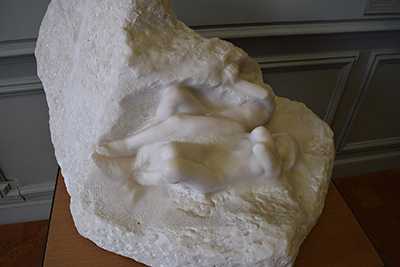Adam and Eve featured several times in the career of Auguste Rodin, sometimes in single figure portraits and other times together. This particular sculpture from 1905 was produced in marble and is also known by some as Adam and Eve Sleeping.
The influence of Michelangelo can be found within this sculpture with the heavy contrast between the smooth and rough edges of the piece. Rodin travelled to Italy to study the work of both Michelangelo and also Bernini and took a lot from both. He re-used this method of making it appear that the sculpture had essentially appeared from nature itself and it was one of his favourite techniques used by the great Renaissance master. Whilst being confident in his own work, he still understood the greatness of others and was never ashamed to admit when he was astounded by the work of sculptors from the past. Living in Paris also meant he could see great sculpture in person without travelling to Italy too often, with the Louvre being as impressive then as it is now. Over the centuries, many artists have spent time here, sketching some of its masterpieces in order to develop their own work.
Whilst Adam and Eve appear several times within his career, it is entirely possible that they were not in his mind when he commenced this sculpture. Rodin would change the titles of his creations many times, normally waiting until after the piece was finished before daring to name it. It may simply have been a relaxed work which started to form an idea in his head over time, leading to the name that he eventually used.
This particular piece is believed to be in the collection of the Musee Rodin, the best art gallery in which to see this artist's work. They have worked hard over the past century to document thousands of items from his lifetime and have even re-used some of his own models in order to provide fresh sculptures to a number of art insititutions. This has also helped to ensure the financing of this important venue that was once home to the artist himself. Within their collection are several notable sculptures as well as a whole plethora of models, study pieces as well as drawings, paintings and thousands of photographs. It is an incredible insight into almost every aspect of his life and also helps to bring to life the words of his biographer, with evidence to back up all that she noted during his lifetime.




